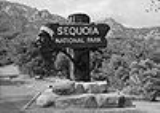
Ash Mountain Entrance Sign
Encyclopedia
The Ash Mountain Entrance Sign at Sequoia National Park
was constructed in 1935 by Civilian Conservation Corps
craftsmen. Featuring a carved Native American
face, the sign was made from blocks of sequoia
wood and fastened with wrought iron brackets.
The design was first proposed by National Park Service
architect Merel S. Sager in 1931, who designed a small log sign for the Ash Mountain entrance. In 1935 resident park landscape architect Harold G. Fowler created a much larger design. He recruited CCC worker George W. Munro, who had displayed a talent for woodworking, and they selected a piece of fallen sequoia wood from the Giant Forest
. Fowler sketched the profile in blue chalk on the wood using an Indian Head nickel
as a guide. Munro carved the wood over a several-month period and the sign was assembled and erected over the winter of 1935-36. It was moved in 1964 to make room for a new park entrance station.
The sign is supported by a four-foot-diameter sequoia log rising from a two-tiered masonry platform. The sign panel is ten feet wide by four feet high and one foot thick, carved into a profile reputed to signify Sequoyah
, whose Cherokee
tribe never inhabited California
. The sign was originally unpainted, but assumed its present appearance in the 1950s. As originally built, a matching log pylon stood on the opposite side of the road. The pylon was removed when the sign was relocated.
Sequoia National Park
Sequoia National Park is a national park in the southern Sierra Nevada east of Visalia, California, in the United States. It was established on September 25, 1890. The park spans . Encompassing a vertical relief of nearly , the park contains among its natural resources the highest point in the...
was constructed in 1935 by Civilian Conservation Corps
Civilian Conservation Corps
The Civilian Conservation Corps was a public work relief program that operated from 1933 to 1942 in the United States for unemployed, unmarried men from relief families, ages 18–25. A part of the New Deal of President Franklin D...
craftsmen. Featuring a carved Native American
Native Americans in the United States
Native Americans in the United States are the indigenous peoples in North America within the boundaries of the present-day continental United States, parts of Alaska, and the island state of Hawaii. They are composed of numerous, distinct tribes, states, and ethnic groups, many of which survive as...
face, the sign was made from blocks of sequoia
Sequoiadendron
Sequoiadendron giganteum is the sole living species in the genus Sequoiadendron, and one of three species of coniferous trees known as redwoods, classified in the family Cupressaceae in the subfamily Sequoioideae, together with Sequoia sempervirens and...
wood and fastened with wrought iron brackets.
The design was first proposed by National Park Service
National Park Service
The National Park Service is the U.S. federal agency that manages all national parks, many national monuments, and other conservation and historical properties with various title designations...
architect Merel S. Sager in 1931, who designed a small log sign for the Ash Mountain entrance. In 1935 resident park landscape architect Harold G. Fowler created a much larger design. He recruited CCC worker George W. Munro, who had displayed a talent for woodworking, and they selected a piece of fallen sequoia wood from the Giant Forest
Giant Forest
The Giant Forest, famed for its giant sequoia trees, is within Sequoia National Park. This montane forest, situated at over above mean sea level in the western Sierra Nevada of California, covers an area of...
. Fowler sketched the profile in blue chalk on the wood using an Indian Head nickel
Indian Head nickel
The Buffalo nickel or Indian Head nickel was a copper-nickel five-cent piece struck by the United States Mint from 1913 to 1938. It was designed by sculptor James Earle Fraser....
as a guide. Munro carved the wood over a several-month period and the sign was assembled and erected over the winter of 1935-36. It was moved in 1964 to make room for a new park entrance station.
The sign is supported by a four-foot-diameter sequoia log rising from a two-tiered masonry platform. The sign panel is ten feet wide by four feet high and one foot thick, carved into a profile reputed to signify Sequoyah
Sequoyah
Sequoyah , named in English George Gist or George Guess, was a Cherokee silversmith. In 1821 he completed his independent creation of a Cherokee syllabary, making reading and writing in Cherokee possible...
, whose Cherokee
Cherokee
The Cherokee are a Native American people historically settled in the Southeastern United States . Linguistically, they are part of the Iroquoian language family...
tribe never inhabited California
California
California is a state located on the West Coast of the United States. It is by far the most populous U.S. state, and the third-largest by land area...
. The sign was originally unpainted, but assumed its present appearance in the 1950s. As originally built, a matching log pylon stood on the opposite side of the road. The pylon was removed when the sign was relocated.
See also
- East Entrance Sign (Zion National Park)
- South Entrance Sign (Zion National Park)
External links
- Parkitecture in the Western Parks: Gateways National Park Service

